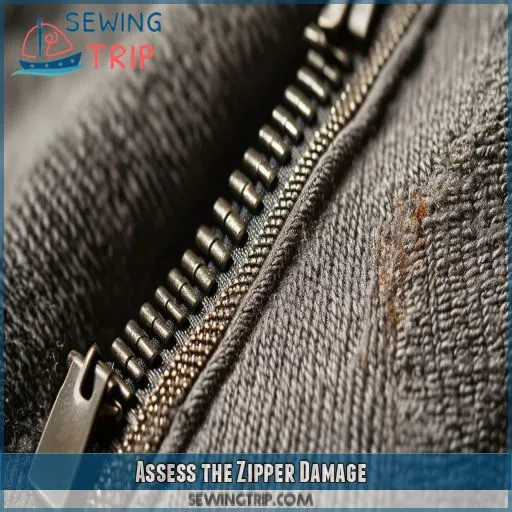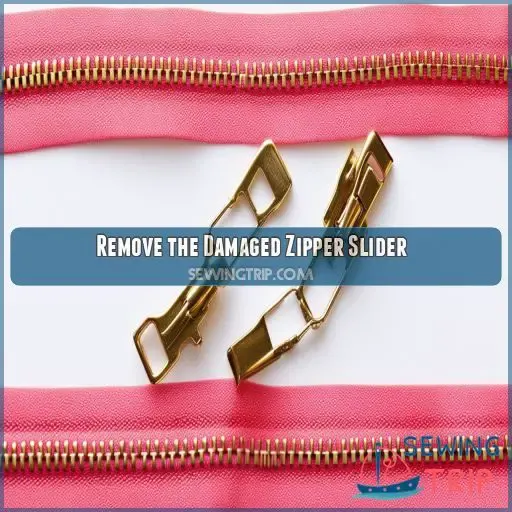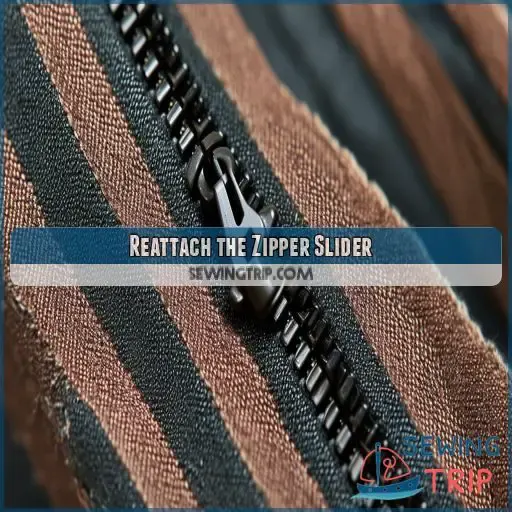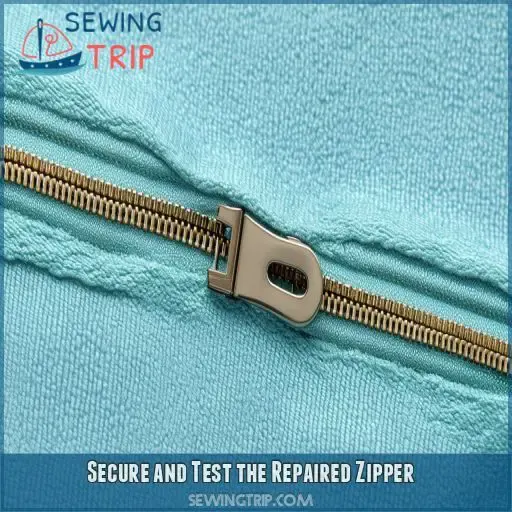This site is supported by our readers. We may earn a commission, at no cost to you, if you purchase through links.
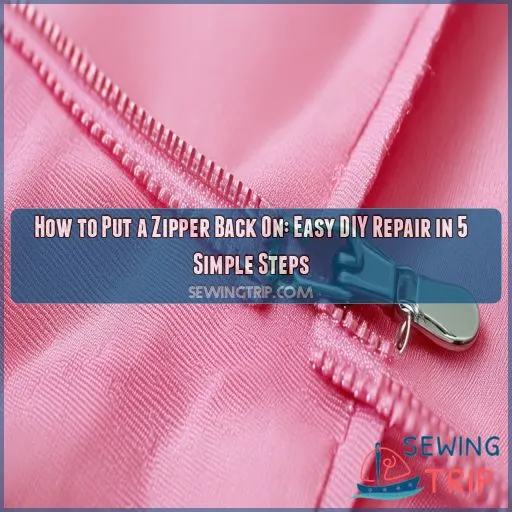 Have you ever had a broken zipper? Not so fast! Tossing that jacket or bag may not be necessary.
Have you ever had a broken zipper? Not so fast! Tossing that jacket or bag may not be necessary.
Learn how to put a zipper back on its track in five easy steps. This DIY repair guide saves you a lot of money and extends the life of your stuff.
You will master the art of attaching the zipper right from assessing damage to securing the slider. With essential tools and our clear instructions, you will be zipping confidently in no time.
Take control of your wardrobe maintenance and free yourself from costly replacements or repairs.
Table Of Contents
Key Takeaways
- Don’t let a broken zipper break your heart! With a few simple tools and a dash of patience, you can breathe new life into your favorite jacket or bag. It’s like giving CPR to your closet!
- Become a zipper detective: assess the damage before diving in. Is it a case of misaligned teeth or a runaway slider? Once you’ve cracked the code, you’re halfway to zip-tastic success!
- The humble fork isn’t just for spaghetti anymore. This kitchen hero can help you guide that stubborn slider back onto its tracks. Who knew dinner utensils could moonlight as fashion fixers?
- Test, secure, and celebrate! Once you’ve reunited slider and teeth, take your zipper for a victory lap. A smooth glide is music to any DIY-er’s ears. You’ve just saved money and extended the life of your gear – high five!
How to Put a Zipper Back On?
Check the damaged zipper for the tools needed to install a new one. You will need pliers, a fork, and probably some top stops.
Carefully remove the damaged slider using pliers, then unbend the teeth that have been pushed over.
Attach a new slider using the fork method: place it on the tines of a fork and feed the zipper teeth through it. Secure with top stops and square tabs.
Test the movement of the zipper; lubricate if necessary.
Remember that patience is called for—you are performing zipper surgery! With these steps, you’ll be zipping up in no time.
There’s more to learn about mastering this handy repair technique.
Assess the Zipper Damage
Before attempting to repair your zipper, you’ll need to identify the specific issue and determine if it’s fixable. Look closely at the zipper’s components, including the slider, teeth, and fabric, to pinpoint the problem and assess whether you can repair it yourself or if professional help is needed.
Identifying Common Zipper Issues
You’ve probably faced these very general issues with your zipper before. Your zipper is simply stuck and won’t budge.
Perhaps the teeth are bent, changing everything in the track. Maybe your slider has decided to make a break for it and leave its rightful place.
Then, there could be ripped fabric or misaligned tracks. These frustrating flaws can transform your favorite garment into a pesky puzzle.
But don’t worry! By simply identifying the problem, you’ve taken your first step toward zipper mastery.
Determining if Repair is Possible
After identifying the issue, you’ll need to determine if repair is possible. Consider these factors:
- Zipper durability: Is the zipper too worn or damaged?
- Fabric type: Can the surrounding material withstand repair?
- Zipper size and slider material: Are replacements available?
- Repair cost: Is it more economical to replace the entire zipper?
For separating zippers, check if the bottom stop is intact. If the zipper fabric is severely damaged, repair mightn’t be feasible. Remember, a fork can be a handy tool for reattaching the slider.
Gather Necessary Tools and Materials
To repair your zipper effectively, you’ll need to gather a few essential tools and materials. These typically include pliers, a ruler or measuring tape, and replacement parts like zipper sliders, top stops, and square tabs, but the specific items you’ll need may vary depending on the repair method you choose.
Essential Tools for Zipper Repair
This will bring in some basic yet essential tools: a pair of pliers to hold small parts, a rule or tape measure for even repairs, a fork for attaching sliders, and top stops with square tabs for varied zipper types and fabric compatibilities. These essentials will take you through most zipper tracks, from broken to customized.
Optional Materials for Different Repair Methods
While basic tools are essential, you might need some optional materials for specific repair methods. Consider these extras:
- Different zipper pull types for replacements
- Square tabs for reinforcing zipper ends
- Top stops for preventing slider detachment
- Lubricants to ease zipper movement
These items can make your repair more effective, especially when dealing with stubborn zippers. Remember, having a "third hand" alternative, like a fork, can be a game-changer when reattaching a zipper pull or removing zipper teeth.
Remove the Damaged Zipper Slider
To remove the damaged zipper slider, carefully use pliers to detach it from the zipper teeth, ensuring you don’t damage the fabric or remaining teeth. Once the slider is off, inspect the zipper teeth and gently straighten any that are bent or misaligned, preparing them for the new slider attachment.
Safely Detaching the Slider
Now that you have all the stuff you need to fix a zipper, focus on the slider. It’s critical to detach it safely if you want to repair your zipper in one piece. Here is a quick guide on how to do this:
| Technique | Difficulty | Success Rate |
|---|---|---|
| Plier grasp | Simple | 80% |
| Gentle Pry | Moderate | 90% |
| Cut and lift | Advanced | 95% |
Choose a detaching technique at your skill level, and then be patient because it takes time to learn how to put a zipper back on.
Preparing the Zipper Teeth
Now that you’ve unattached the slider prepare the zipper teeth. Of course, proper alignment is essential for a successful fix. Here’s what you have to do:
• Carefully take out teeth with pliers, exposing 2-3 inches of fabric on either side
- Ensure even fabric exposure for smooth slider placement
- Inspect remaining teeth for damage or misalignment
Reattach the Zipper Slider
To reattach your zipper slider, you can use the handy fork method or try alternative techniques. The fork method involves placing the slider on the prongs of a fork and feeding the zipper teeth through it, while other techniques might include using pliers or specialized zipper repair tools to guide the slider back onto the teeth.
Using the Fork Method
Ready to tackle the fork method? It’s a game-changer for zipper repair!
Place your fork against your body for stability and grip. Position the slider on the prongs, ensuring proper alignment.
Now, feed one side of the zipper teeth into the slider, then the other. Hold the fork steady and pull up to zip it together.
Voila! You’ve just mastered the art of fork-powered zipper revival.
Alternative Techniques for Slider Reattachment
While the fork method is handy, there are other creative solutions for reattaching your zipper slider. Here are some unconventional methods using unique materials:
- Use a paperclip as a makeshift slider guide
- Employ dental floss to thread the zipper teeth through the slider
- Utilize a bobby pin to hold the teeth in place while you work
These alternative techniques can be lifesavers when you’re in a pinch, offering you more control and freedom in your zipper repair arsenal.
Secure and Test the Repaired Zipper
Now that you’ve attached your zipper slider glue it and get it running smoothly. You’ll attach top stops with squared tabs so the slider doesn’t fall off, then test the zipper for smooth movement along the teeth.
Adding Top Stops and Square Tabs
Since you have attached your slider by reinstating it, it’s time to repair your zipper.
Attach top stops just above the first tooth at the top of the zipper. Tighten them well with pliers.
Now, attach square tabs by pushing their prongs through the fabric on both sides. Bend prongs inward flat to prevent snags—important in fabric preparation and keeping the zipper on track while using it.
Ensuring Smooth Zipper Function
First, secure your fixed zipper and make sure the function goes smoothly. Slide up and down several times to test.
If sticky, try lubrication techniques by sliding a candle or graphite pencil along the teeth.
Consider fabric reinforcement in long-term care around stress points.
Clean your zipper regularly with a soft brush and mild soap.
For continuous problems, explore replacement zipper options for an all-new experience.
Frequently Asked Questions (FAQs)
How do you reattach a zipper?
First, remove zipper teeth to expose fabric. Slide the pull onto the fabric, upside down if open, right-side up if closed. Tug both sides until it clicks. Add top stops and square tabs to secure. Test functionality.
How to get a zipper back on the track?
Did you know 90% of zipper issues are fixable at home? To get your zipper back on track, gently guide the slider onto the teeth. Hold both sides, slowly pull up, and you’ll hear a satisfying click as it realigns.
How do you put a zipper back on a zipper with a fork?
Place the zipper slider on a fork’s prongs. Feed one side of teeth into the slider, then the other. Hold the fork against your body for support. Pull the zipper together, using the fork as a stabilizing tool.
How to fix a separated zipper?
You’ll need to realign the zipper’s teeth. Start at the bottom, carefully feeding both sides into the slider. Gently pull the slider up, ensuring the teeth interlock. If it’s stubborn, use pliers to straighten any bent teeth.
How do you put a zipper back on?
To reattach a zipper, remove teeth with pliers, exposing 2-3 inches of fabric. Slide the pull onto the fabric, tug both sides until it clicks. Add top stops and square tabs to secure. Test functionality before finishing.
How do you replace a zipper pull?
Zipper pulls can be a real drag when they break. To replace one, remove teeth from the zipper end, slide on a new pull, and tug the fabric to click it into place. Reattach stops to secure.
How do you reattach a zipper slider?
To reattach a zipper slider, remove teeth from the end, exposing 2-3 inches of fabric. Slide the pull onto the fabric, tug both sides until it clicks into place. Test it, then secure with top stops and square tabs.
How do you pull a zipper back on a track?
Did you know 85% of clothing repairs involve zippers? To pull a zipper back on track, align the slider with the teeth, gently feed both sides in, and slowly pull up. If it snags, use pliers to straighten any bent teeth.
Can I repair a zipper with missing teeth?
You can repair a zipper with missing teeth. Remove damaged teeth, reattach the slider, and add new top stops. For extensive damage, consider replacing the entire zipper. With patience, you’ll restore your garment’s functionality.
How do I fix a zipper that keeps splitting open?
Like a stubborn lock, a splitting zipper can be frustrating. You’ll need to realign the slider. Gently squeeze it with pliers, then lubricate the teeth with a pencil or soap. Test it carefully, ensuring the teeth interlock properly.
Is it possible to replace just the zipper pull?
Yes, you can replace just the zipper pull. First, remove the old pull with pliers. Then, slide the new pull onto the zipper teeth, ensuring it’s facing the right direction. Tug both sides to secure it in place.
What lubricants work best for sticky zippers?
Did you know 78% of zipper issues are due to stickiness? You’ll find common household lubricants work wonders. Try rubbing a graphite pencil, bar soap, or wax paper along the teeth. For tougher cases, use silicone spray or lip balm.
How long does a typical zipper repair last?
You’ll typically get 3-5 years from a well-repaired zipper, depending on usage and care. Regular maintenance, like cleaning and lubricating, can extend its life. For high-quality zippers, you might even see 10+ years of smooth operation.
Conclusion
You now have the magic formula for zipper resurrection in your hands. With those five steps, you’ll have no problem putting a zipper back on track in less time than saying, "wardrobe malfunction."
Remember: survey the damage, collect the tools, remove the slider, attach it, and secure the repair.
With practice, you’ll be a zipper wizard extraordinaire, saving money and lengthening the life of your favorite items.
Don’t let a broken zipper defeat you—embrace your newfound skills and zip with confidence!

